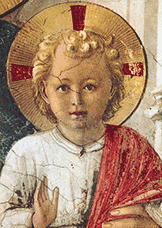Christianity has given a particular importance to childhood. It certainly transformed, over time, the way children were perceived in classical civilizations. From the statement of Christ, “Whoever does not receive the kingdom of God like a child shall not enter it” (Mk 10:15), it followed that there was something valuable and to be imitated in the state of childhood. Normally children are told to grow up and become like adults, not the other way around. Childhood is an undeveloped stage, but in some ways it also represents a more perfect state, in which we
can see more completely what it is simply to be human. Until Mary Immaculate, no one had lived that human existence perfectly, but in her and in her newborn Child we see what it is to receive one’s being straight from the hand of God and to show forth what it is to be loved and to love.
This is not to romanticize or idealize childhood, but to understand it in the light of a new fact: the Incarnation of the second person of the divine Trinity. God has a Son. We are made in God’s image. The child from its first moment is the paradigm for the image of God, as well as a revelation of the meaning of being – its meaning as pure gift. This primordial meaning of the child is present even in fallen man, but clouded over and confused as time goes by and as the child grows.
The great educators have learned to appreciate the various stages of childhood and adolescence as the unfolding of human potential. Howard Gardner’s theory of “multiple intelligences” was welcomed by many teachers (if not by most psychologists) because it seemed to confirm their experience of the multi-faceted nature of that potential, and gave them a vocabulary in which to discuss it. But intelligence, even in the plural, needs to be integrated within a broader theory of the human person as the manifestation of Being.
The child who has not yet sinned – or in the case of Mary and Jesus, the child who never sins – lives partly in eternity even while on earth; he has the fragrance of eternity around him. Purity is the reason childhood is so fascinating. To be pure is to be simple, in the sense of undivided. Impurity involves a loss of integrity, of integration; it is a dissonance, a crack in the mirror of the soul. (Every sin sets part of me against the rest.) The pure gaze of innocence is one that does not secretly look for what can be got out of something or someone. It sees things as they are in their own right. The energy behind the gaze is not diverted by a variety of passions. When a baby wants something, it wants that thing completely. Thus the child lives each moment more intensely than those who have grown old in sin. His eyes are clearer, his ears keener, his energy stronger. He lives in a wider universe, one that seems to go on forever, for he has not had the experience of many winters and summers, and of the flickering parade birthdays coming and going through the years. He has no yardstick against which to measure his life. This intensity of experience is partly a function of the way memory and imagination work. It is the memory of time that makes us old; remembering eternity makes us young again.
The first priority of the Catholic school must be to preserve and nurture the spirit of childhood in this sense – to preserve and help to restore (through the sacraments, especially the sacrament of confession) the purity that alone enables us to “see God” (Matt. 5:8). The rules of morality are not there primarily for the sake of social order, tradition or convention; they exist for the sake of the order of the soul, its spiritual development and happiness. Yet an overly moralistic approach would be counter-productive. Not only can we not rely on rules and the policing of corridors for the preservation of purity and the development of conscience, these are not even the best way to begin. The soul needs love, as the positive force around which all its powers will congregate. It needs a degree of tenderness, if it is to flourish without fear. It needs attention, in the sense that others – the teacher especially – must listen to it and be receptive to what it has to offer, if it is to discover for itself what that is.
This was the third of three extracts from a work in progress.

When will the "work in progress" come to light? Is "Beauty for Truth's Sake" worth reading as a guide to early childhood education?
ReplyDeleteI am a Catholic father of four, the oldest of which is in Waldorf first grade after a seemingly enriching experience in Waldorf pre-K. (The second child has Phalen McDermid Syndrome... guiding the development of the mentally disabled seems to have its own set of interesting issues!)
Catholic education around here (Chicago) seems... shall we say, uninspired? Am I right? Can Catholic education learn from Waldorf? Can Waldorf learn from Catholic educators? ...which Catholic educators??
I'm a Tomberg fan, by the way, although hopefully one resting in the "calm centre of Catholic truth." :)